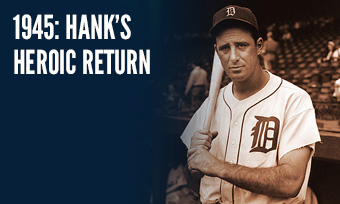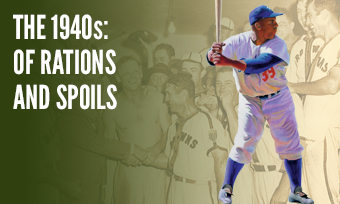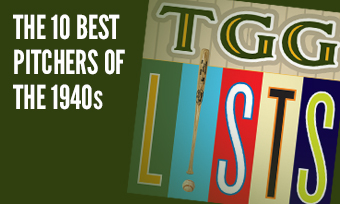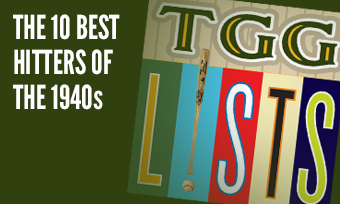The Yearly Reader
Leaders and Honors, 1945
Our list of baseball’s top 10 hitters and pitchers in both the American League and National League for the 1945 baseball season, as well as the awards and honors given to the game’s top achievers of the year.
The National League’s Top 10 Hitters, 1945
Bold type in brick red indicates league leader.
1. Tommy Holmes, Boston
Key Numbers: .352 average, 125 runs, 224 hits, 47 doubles, 8 triples, 28 home runs, 117 RBIs, 70 walks, 15 stolen bases, .577 slugging percentage.
Holmes managed a feat more impressive than his 37-game hitting streak: Leading the NL in home runs while striking out just nine times.
2. Phil Cavarretta, Chicago
Key Numbers: .355 average, 94 runs, 177 hits, 34 doubles, 10 triples, 6 home runs, 97 RBIs, 81 walks, .449 on-base percentage.
The longtime Cubs first baseman continued his ascent from star to superstar against weakened wartime pitching.
3. Augie Galan, Brooklyn
Key Numbers: .307 average, 114 runs, 177 hits, 36 doubles, 7 triples, 9 home runs, 92 RBIs, 114 walks, 13 stolen bases.
Though he’d still be an effective player for the remainder of the decade, the thirtysomething Galan completed his late-career rebirth thanks to inferior wartime competition.
4. Dixie Walker, Brooklyn
Key Numbers: .300 average, 102 runs, 182 hits, 42 doubles, 9 triples, 8 home runs, 124 RBIs, 75 walks.
Walker became the last player to date to lead either league in RBIs with less than 10 home runs.
5. Whitey Kurowski, St. Louis
Key Numbers: 133 games, .323 runs, 84 runs, 165 hits, 27 doubles, 21 home runs, 102 RBIs.
While some players listed on this page went from stud to scrub once the real major leaguers returned from war, Kurowski would prove over the next few years that his wartime numbers were no padded fluke.
6. Goody Rosen, Brooklyn
Key Numbers: .325 average, 126 runs, 197 hits, 24 doubles, 11 triples, 12 home runs, 75 RBIs.
The Toronto native’s second stint with the Dodgers—he played at Brooklyn from 1937-39, then vanished to the minors for four seasons—peaked with an impressive array of numbers.
7. Mel Ott, New York
Key Numbers: 135 games, .308 average, 21 home runs, 79 RBIs, 71 walks, 8 hit-by-pitches.
In essentially his final year as a player before taking on sole managerial duties in 1946, the 36-year-old Ott led the Giants for the 18th straight year in home runs.
8. Stan Hack, Chicago
Key Numbers: .323 average, 110 runs, 193 hits, 29 doubles, 7 triples, 99 walks, 12 stolen bases.
Enjoying his final hurrah as an everyday player before assuming part-time postwar duty, Hack became the first modern-era Cub to amass 2,000 hits.
9. Buster Adams, Philadelphia-St. Louis
Key Numbers: .287 average, 104 runs, 182 hits, 29 doubles, 22 home runs, 109 RBIs.
Adams did his best to impersonate the absent Stan Musial after being traded early in the year from Philadelphia; he’d hit .185 in 1946 against the regulars returning from war.
10. Andy Pafko, Chicago
Key Numbers: .298 average, 24 doubles, 12 triples, 12 home runs, 110 RBIs, 8 hit-by-pitches, 21 sacrifice hits.
Barred from military service due to high blood pressure, the 23-year-old Pafko emerged into a wartime star who would only keep growing once peace returned.
The American League’s Top 10 Hitters, 1945
1. Snuffy Stirnweiss, New York
Key Numbers: .309 average, 632 at-bats, 107 runs, 195 hits, 32 doubles, 22 triples, 10 home runs, 64 RBIs, 78 walks, 33 stolen bases, 17 caught stealing, .476 slugging percentage.
Stirnweiss capped his brief wartime reign as the AL’s best by winning the batting title on the final day.
2. Roy Cullenbine, Cleveland-Detroit
Key Numbers: .272 average, 83 runs, 28 doubles, 5 triples, 18 home runs, 93 RBIs, 113 walks.
After an early-season trade to the Tigers, Cullenbine hit full gear once inserted in the #5 spot of the lineup, hitting .302. Reason: The recently returned Hank Greenberg was hitting fourth.
3. Nick Etten, New York
Key Numbers: .285 average, 77 runs, 161 hits, 24 doubles, 18 home runs, 111 RBIs, 90 walks.
In his last full year, Etten admirably held the fort for the Yankees as their premier slugger until the late-season return of Charlie Keller.
4. Vern Stephens, St. Louis
Key Numbers: .289 average, 90 runs, 165 hits, 27 doubles, 24 home runs, 89 RBIs.
Stephens hit nearly 100 points better at home (.332 at Sportsman’s Park vs. .246 on the road) and became the only AL home run leader the Browns/Orioles could boast between 1922 (Ken Williams) and 1965 (Frank Robinson).
5. Joe Kuhel, Washington
Key Numbers: .285 average, 29 doubles, 13 triples, 2 home runs, 75 RBIs, 79 walks, 10 stolen bases.
It’s true: The 39-year-old Kuhel hit the one and only home run hit by the Senators at Griffith Stadium all year long. It was an inside-the-park job.
6. Eddie Lake, Boston
Key Numbers: 133 games, .279 average, 81 runs, 27 doubles, 11 home runs, 51 RBIs, 106 walks, .412 on-base percentage.
A .220 career hitter minus his 1945 numbers, Lake was going to miss that diluted pitching.
7. Jeff Heath, Cleveland
Key Numbers: 102 games, .305 average, 15 home runs, 61 RBIs, 56 walks, 13 intentional walks, .508 slugging percentage.
Heath was ‘officially’ the only American Leaguer to slug over .500, though with today’s eligibility requirements he would have fallen short of the 3.1 plate appearances per game to qualify.
8. Wally Moses, Chicago
Key Numbers: .295 average, 79 runs, 168 hits, 35 doubles, 15 triples, 69 walks, 11 stolen bases.
The end of the war would also bring an end to the inflated, belated stardom of aging vet Moses.
9. Bob Johnson, Boston
Key Numbers: .280 average, 27 doubles, 7 triples, 12 home runs, 74 RBIs, 63 walks.
A muted but worthy farewell season for the 39-year-old Johnson, another once-stellar player whose career was prolonged by war; in only three of his 13 big-league seasons, his team finished above .500.
10. Johnny Dickshot, Chicago
Key Numbers: 130 games, .302 average, 19 doubles, 10 triples, 18 stolen bases.
One-year stardom came to the man self-described as the ugliest in baseball—and you’d also have a sense of humor if your name was Johnny Dickshot.
The National League’s Top 10 Pitchers, 1945
1. Claude Passeau, Chicago
Key Numbers: 2.46 ERA, 17 wins, 9 losses, 34 appearances, 27 starts, 5 shutouts, 227 innings.
The veteran right-hander, at age 36, cleared 15 wins for the seventh straight year after failing to do it once in his early campaigns with the pitiful Phillies of the 1930s.
2. Hank Wyse, Chicago
Key Numbers: 2.68 ERA, 22 wins, 10 losses, .688 win percentage, 38 appearances, 34 starts, 23 complete games, 278.1 innings, 55 walks, 30 grounded into double plays.
In his one glorious campaign before the returning regulars turned him back into a frog, Wyse anchored baseball’s toughest pitching staff in Chicago.
3. Red Barrett, Boston-St. Louis
Key Numbers: 3.00 ERA, 23 wins, 12 losses, 45 appearances, 34 starts, 24 complete games, 284.2 innings, 54 walks.
The Braves anted up $60,000 and gave it to St. Louis along with the unsung pitcher in exchange for established ace Mort Cooper; Barrett shined, Cooper floundered, and the Cardinals laughed all the way to the bank.
4. Harry Brecheen, St. Louis
Key Numbers: 2.52 ERA, 15 wins, 4 losses, .789 win percentage, 24 appearances, 18 starts, 157.1 innings.
Almost a decade after Cardinals slugger Johnny Mize laid claim to the nickname “The Big Cat,” Here came “The Cat”—though at 5’10” and 160 pounds, it might have been more apt to go with “Little Cat.” Nevertheless, Brecheen finished a three-year stretch resulting in a composite 40-18 record and 2.58 ERA; more success lay ahead.
5. Ray Prim, Chicago
Key Numbers: 2.40 ERA, 13 wins, 8 losses, 34 appearances, 19 starts, 165.1 innings, 23 walks.
Nicknamed “Pop” for his gray-haired appearance, the 38-year-old Prim reserved his spot as a one-year wartime wonder by mixing a decent fastball with a nasty screwball.
6. Ken Burkhart, St. Louis
Key Numbers: 2.90 ERA, 18 wins, 8 losses, .692 win percentage, 42 appearances, 22 starts, 217.1 innings.
Like Hank Wyse above, the rookie righty fattened up his numbers against weaker wartime competition before reality set in with the return of the regulars.
7. Nick Strincevich, Pittsburgh
Key Numbers: 3.31 ERA, 16 wins, 10 losses, 36 appearances, 29 starts, 228.1 innings, 49 walks.
A solid wartime asset for the Bucs, Strincevich would stick it out and pitch decently in 1946—before his career fell apart.
8. Preacher Roe, Pittsburgh
Key Numbers: 2.87 ERA, 14 wins, 13 losses, 31 starts, 235 innings, 46 walks, 148 strikeouts.
Relatively poor run support—especially within his home base at Forbes Field, where he only won five games—kept the second-year Roe from garnering a better record. He’d make up for it in the years to come at Brooklyn.
9. Van Lingle Mungo, New York
Key Numbers: 3.20 ERA, 14 wins, 7 losses, 26 starts, 7 complete games, 183 innings.
The 1930s workhorse, whose star had long since faded under the weight of alcohol and scandal, had one last hurrah at age 34—with his most impressive feat being sober through it all.
10. Hal Gregg, Brooklyn
Key Numbers: 3.47 ERA, 18 wins, 13 losses, 42 appearances, 34 starts, 254.1 innings, 120 walks.
Yes, the tall, second-year right-hander led the NL walks for a second straight season—but at least he didn’t also lead in runs allowed, wild pitches and hit batsmen as he did in 1944.
The American League’s Top 10 Pitchers, 1945
1. Hal Newhouser, Detroit
Key Numbers: 1.81 ERA, 25 wins, 9 losses, .735 win percentage, 40 appearances, 36 starts, 29 complete games, 8 shutouts, 313.1 innings, 110 walks, 212 strikeouts, 10 wild pitches.
Newhouser thoroughly dominated the AL stat charts and deservedly became the only pitcher conquer back-to-back MVPs.
2. Roger Wolff, Washington
Key Numbers: 2.12 ERA, 20 wins, 10 losses, 33 appearances, 29 starts, 250 innings, 53 walks.
Wolff won 20 at Washington a year after a 4-15 mark, and a year before finishing at 5-8.
3. Nels Potter, St. Louis
Key Numbers: 2.47 ERA, 15 wins, 11 losses, 32 starts, 255.1 innings, 13 intentional walks.
Potter produced the Browns’ best ERA since 1919 and the end of the Deadball Era.
4. Dutch Leonard, Washington
Key Numbers: 2.12 ERA, 17 wins, 7 losses, .708 win percentage, 29 starts, 216 innings, 35 walks.
Leonard’s knuckleball wasn’t only effective, it was, by knucklers’ standards, very much in control; he only walked 35 batters. Still, he made life rough for Senators catchers, who committed 14 total passed balls when he pitched.
5. Steve Gromek, Cleveland
Key Numbers: 2.55 ERA, 19 wins, 9 losses, .677 win percentage, 30 starts, 251 innings.
Gromek was the Indians’ best pitcher…until Bob Feller returned late in the year.
6. Boo Ferriss, Boston
Key Numbers: 2.96 ERA, 21 wins, 10 losses, .677 win percentage, 35 appearances, 31 starts, 26 complete games, 264.2 innings.
Ferriss set the pace for his magnificent rookie year by not being scored upon over his first 22 innings of work.
7. Al Benton, Detroit
Key Numbers: 2.02 ERA, 13 wins, 8 losses, 31 appearances, 27 starts.
Let go by the Navy after two years with migraine issues, Benton authored the year’s longest consecutive scoreless inning streak (33) and didn’t allow more than two runs in either of his first 15 starts—setting a record that would be tied by Hyun-Jin Ryu in 2019.
8. Thornton Lee, Chicago
Key Numbers: 2.44 ERA, 15 wins, 12 losses, 28 starts, 228.1 innings, 10 hit-by-pitches.
A brief return to form for the 22-game winner and ERA champ from 1941, after posting a 10-24 record from 1942-44 with numerous injuries resulting in several operations.
9. Dizzy Trout, Detroit
Key Numbers: 3.14 ERA, 18 wins, 15 losses, 41 appearances, 31 starts, 18 complete games, 246.1 innings, 32 grounded into double plays.
Exhaust played a role in the 1944 über-workhorse’s reduced follow-up, but he contributed in auxiliary ways—posting a 0.96 ERA in 10 relief appearances while smashing five homers and 24 RBIs over 133 at-bats at the plate.
10. Al Hollingsworth, St. Louis
Key Numbers: 2.70 ERA, 12 wins, 9 losses, 26 appearances, 22 starts, 173.1 innings.
A rare case of winning for a pitcher who otherwise compiled a 58-95 record over 10 other major league seasons.









